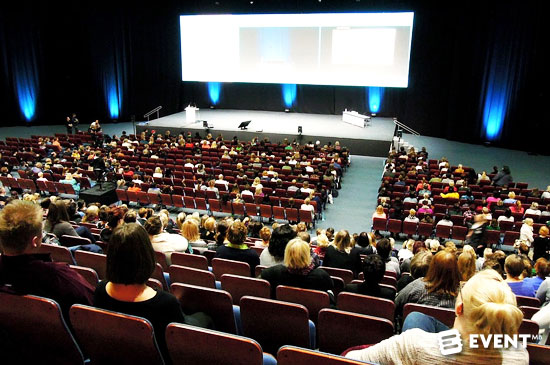Skift Take
You've heard it time and time again at a conference near you. Nobody wants to sit on the front row. Why is that and why it does not happen at other events?
Picture this. You managed to get a ticket to see Hamilton, one of the most in-demand shows on Broadway at the time of writing. There are no assigned seats (hey, let’s pretend). You walk into the theater and to your shock, nobody is sitting in the front row. Everybody is trying to sit as far as possible from the stage.
Now let’s say you were 15 years old in 2013 (hey, let’s pretend) and you managed to get a ticket to see One Direction in London. When you enter Wembley, nobody bothers to be on the pitch watching their idols up close.
What about the final of the US Open? Better to sit close to the exit in section 319 on the upper tier. Courtside is not cool, and you can’t leave as quickly if you are bored.
Crazy huh? Well, that is happening every day at conferences we plan.
Why Is That?
While I was running the content for a trade show in November, I kept asking myself and the audience this question. I had to force people to sit on the front row. It would be a joke in any other type of event, but it is a sad reality in most conferences. Nobody wants to sit on the front row. Perhaps not in keynote sessions with speakers that charge half of your budget, but surely in the remaining 95% of your program.
Here are some of the reasons I thought about. Maybe you can add some more:
– I don’t care about your speaker. Oh, so your speaker came mainly to promote their consultancy. I want to be as close to the exit as possible so I can run away at the first attempt to promote what they do.
– I don’t care about the topic. You proposed a mildly interesting topic on the program. Running out of options and having to fill in slots, you used what you got. As an attendee, I don’t want to be bothered. I am not engaged, and I don’t care. I just need to rest my feet so I will sit as far as possible so I cannot be involved in the speaker’s interactive games.
– Salespeople abused me. This is particularly the case at exhibitions where content is merged with booths. I have been exposed to so much selling that I am afraid to show an inch of engagement. I am very defensive, I don’t want to show you my vulnerability as I know you will take advantage of it.
– The seating of your session resembles a firing squad, and I don’t want to be executed. We’ve all watched Braveheart. When the Scots are going running towards the English, the first line dies. I am sorry, but they do. If am going to be sitting in the front row, I don’t want to be the first to go down. That may involve picking on me or making me speak. Let’s remind ourselves that speaking in public is feared more than dying. In fact, this feeling is very similar to attending stand-up comedy nights, where you want to be seated as far away as possible from the comedian as they WILL pick on your insecurity.
What Can You Do About It?
Picking up the mic and being the event planner in charge who forces people to sit in the front does not cut it. Modern planners anticipate problems instead of solving them during the event. This is probably the most common problem ever.
Here are some ideas:
– Give rewards. Offer a reward to sit in the front. Show them there is something in it from them
– Research your speaker better. You can’t always have rockstars but make sure there is relevancy in the speakers you summon. Also offer them enough rewards not to pitch what they do at every occasion.
– Cut down on sessions. Less is more. Why do you have to fill your program with sessions nobody cares about? Cut down on sessions, give more time to speakers in demand, give attendees what they want, not what you think they want.
– Research your topics better. There is an incredible amount of data available concerning what your attendees value when it comes to content. Don’t be lazy, do your homework. Search social networks, read trade resources, be an expert in your niche.
– Create a safe environment. It’s great if you offer content during your exhibition. Make sure that the area where you offer content is sales and pitch free, reinforce that with your attendees, let them know they can safely let go within your knowledge hubs.
– Design seating wisely. This is probably the most anticipated issue you WILL experience at your next event. Do something about it. Experiment with new seating arrangements, give pressure to the speaker, not the front row. Don’t be afraid to risk new formats as we all know the result of doing things the same way.
In Conclusion
We need to fix the front row issue at conferences and seating has nothing to do about it. Are we creating events people want to attend? Are we planning sessions attendees can’t wait to sit on the front row for? Are we creating excitement or are we scaring people away?
These are some of the questions we need to ask ourselves when thinking about engaging our attendees. Before looking at what color scheme to use at our next event, we should solve atavistic challenges of our events.







